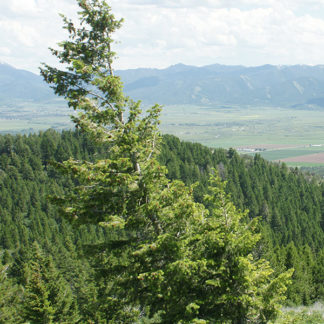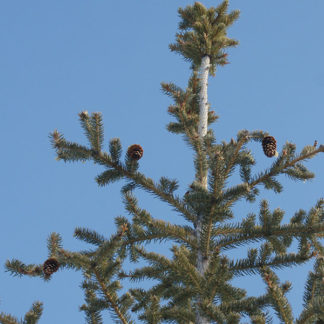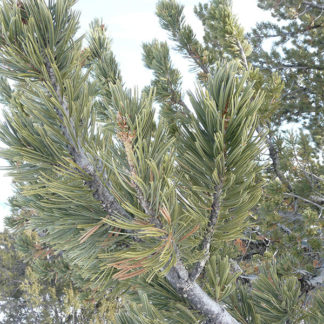Pinaceae
Showing all 7 results
-

Abies lasiocarpa / subalpine fir
- narrow, tall, sharply tipped trees
- cones purple and erect; disintegrate in the fall
- needles flattened, soft and blunt tipped, brushed upward
- needles sessile - no petioles or pegs
- leaf (needle) scars round
-

Picea engelmannii / Engelmann spruce
- common, especially in mixed conifer forests
- canopy a narrow spire in young trees, cylindrical in older trees
- sharp, pointy needles, generally "swept" toward branch tips
- needles attached to twigs with woody pegs (sterigmata)
- pendant cones less than 2.5 inches long; thin scales, wavy margins
-

Picea pungens / Colorado blue spruce
- conical, layered crown; whorled branches
- frequent epicormic branches; "woolly" look
- stout, yellow-brown twigs with sterigmata (woody pegs)
- cones greater than 2.5" long
- cone scales stiff at base, diamond shaped, not wavy at tips
- in mixed conifer forests
-

Pinus albicaulis / whitebark pine
- high altitude - subalpine to alpine; cold, windy sites
- five needles in tight fasicles
- brown to purple cones at top of tree; cones don't open
- scaly grayish bark
-

Pinus contorta / lodgepole pine
- evergreen conifer
- needles in groups (fascicles) of 2
- lopsided cones, (mostly) remain on tree when mature
- rounded crown; orangey-brown scaly bark
-

Pinus flexilis / limber pine
- high elevation, rocky or talus, dry, high-stress habitat
- often - stunted and deformed by wind
- highly flexible branches
- needles in bundles (fascicles) of 5
- often - semi-rotted cones on ground below
-

Pseudotsuga menziesii / Douglas fir
- persistent cones with distinctive 3-pronged, "mouse tail", bracts
- semi-pointy, but not stiff or sharp, single needles
- needles attached to twigs by petioles (no pegs)
- oval leaf scars
- twig buds are pointy, "lustrous" brown
Showing all 7 results